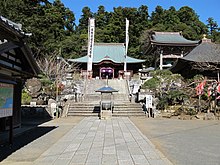Seichō-ji
Seichō-ji (Japanese: 清澄寺), also known as Kiyozumi-dera (清水寺), is a Nichiren Buddhist[2] temple located in the city of Kamogawa in Chiba Prefecture, Japan. Along with Kuon-ji in Yamanashi Prefecture, Ikegami Honmon-ji in the south of Tokyo, and Tanjō-ji also in Kamogawa City, Seichō-ji is one of the "Four Sacred Places of Nichiren Shū."
This article needs additional citations for verification. (April 2018) |
The Buddhist priest Nichiren was once educated at the temple, and was chosen at one time to be a successor to its priesthood before he began his own ministry which later became Nichiren Buddhism. At the time, the temple was dedicated to the Pure Land sect, prior to being a Tendai temple, then later changed into Shingon, and now designated a Nichiren Shu temple.


